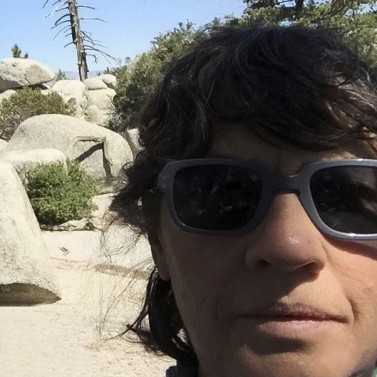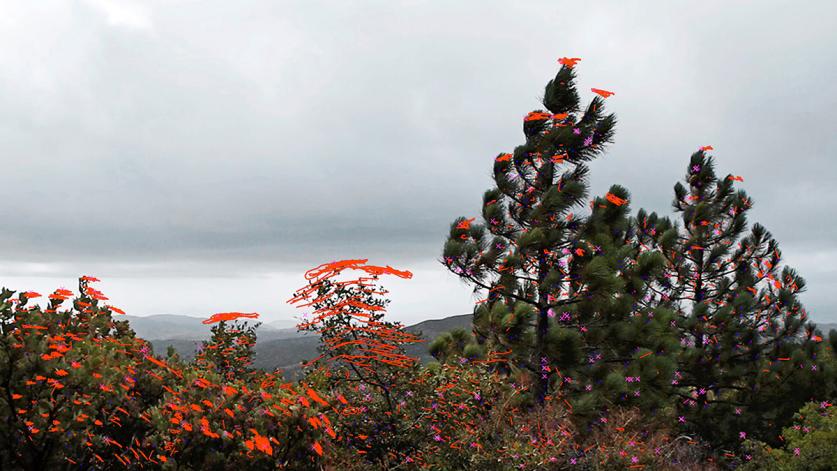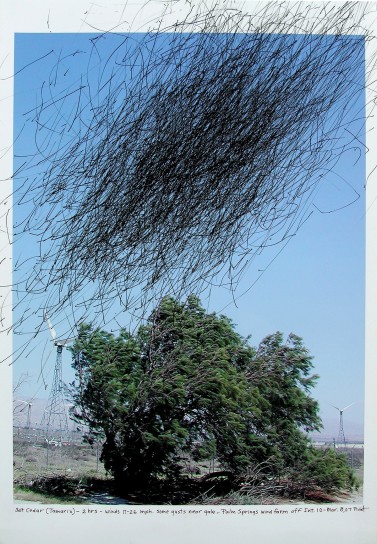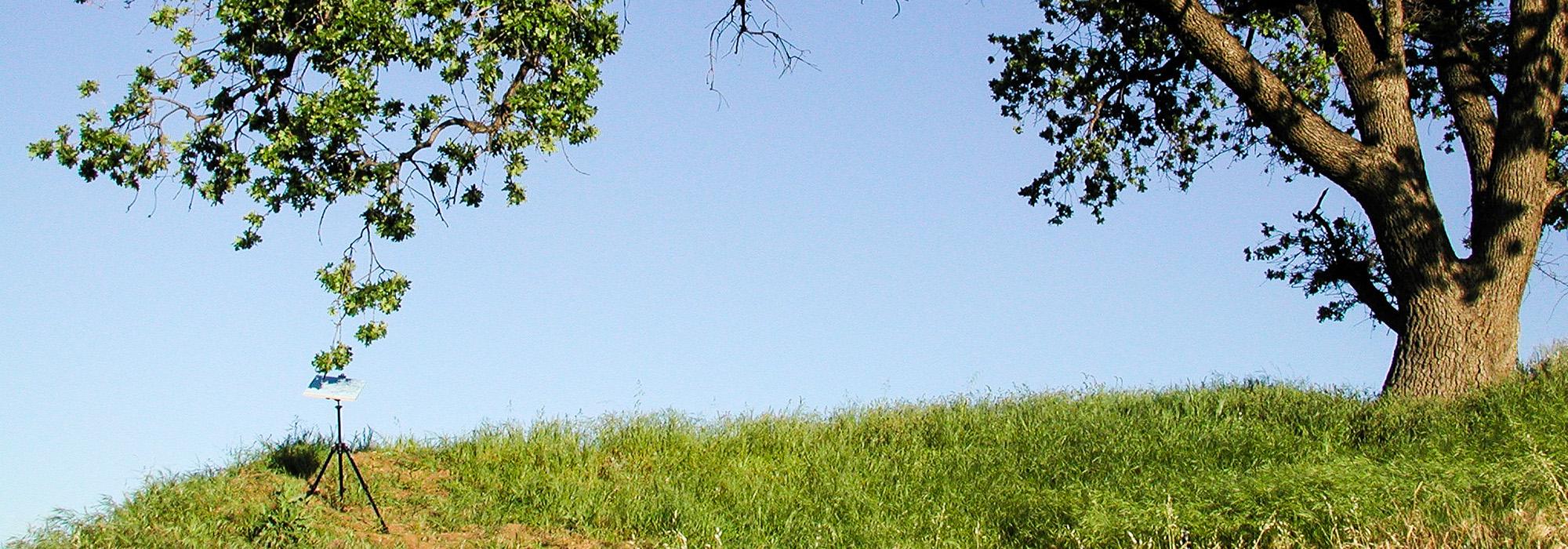It Takes One: Pat Pickett

I’m an artist of the out-of-doors, sensibilities formed during a childhood in the woods and fields of Vermont. I am interested in the physicality and expressiveness of measurable circumstances, and in the accumulation, over time, of this visual information.
How would you define a cultural landscape?
I like to think that all landscape is cultural, from exquisite gardens to rugged wilderness. What looked to early European explorers like an untouched landscape, in places like California, had been shaped by human stewardship for tens of thousands of years. What looks like a pristine wilderness in the Rocky Mountains are stressed homogenetic stands that are the result of more than a hundred years of fire suppression. All of the ways we look at, map, or touch the landscape – they’re always somehow an extension of cultural imagination.
How is your creative process influenced by the landscape? Can you tell us a bit about your work related to the motion/wind/impact on the land?
It began with wanting to get at the heart of the drawing impulse; a response to visual stimulus, and the characteristic marks which are the result. I was searching for a more scientific understanding of the elements in those landscapes I was trying to portray. I wondered… what are the invisible forces underlying the visible landscape? And how do I make pictures of that? At the time I was teaching art history to aeronautical engineering students, and explaining the definition of each medium led me to define drawing as a “reaction to phenomena which results in expressive marks.” I thought… what if I applied that definition to my invisible-forces-in-the-landscape problem? For instance, what if trees reacting to the phenomena of wind (an invisible force) made a kind of halo of marks in the sky? What if trees could make drawings?

It seemed obvious that each tree's marks would be an expression of a particular set of circumstances: species, wind speed, topography, etc. So in 1999 I began with my backyard pear tree. The following year brought a move to California – to a yard with no trees – but I decided that the entire state would be my backyard. I captured tree drawings on prepared wooden panels and on paper, using NOAA (National Oceanographic and Atmospheric Administration) and raw data to chase the wind as I explored the state, and then the country from coast to coast. Still trying to realize my original vision – a halo of expressive marks – I took photos and then returned to the tree to capture the drawing directly on the print. For a while, I experimented with a digital pen, which recorded the sound of the pen scratching across paper while a tiny camera took pictures of its place on the page and made a movie of the drawing as it formed, while I simultaneously filmed the tree making the drawing. It was loads of work, syncing and layering to pull all of that together, which only resulted in a disappointingly awkward relationship between the tree and the drawing.
Now much closer to expressing that "halo of marks," I am currently using video to capture the movements of very large trees, groups of trees, trees at a distance, and difficult-to-access trees. With the assistance of predictive analysis software – aided by artificial intelligence – I trace the paths of the branches as they react to, absorb, and attempt to shed the wind’s energy. The lines traced by following the tree’s movement are moving drawings, and each tells the story of that gust’s effect on the tree.

How does your understanding of the landscape change as a result of your efforts?
In 2006, while looking for information about the effects of wind on trees I discovered the International Wind Effects on Trees Conference, a body of scientists which meets every three years. I have presented my work to four of their conferences, most recently in July 2017 at the National Center for Atmospheric Research in Boulder, Colorado. Each conference serves as an immersive course in the interdisciplinary world of silviculture, wind climatology, wind flow, tree biomechanics, botany, wind damage, forest ecology, storm impacts and risk modeling, wind throw (trees blowing over), stem breakage (tree trunks breaking), tree windfirmness, etc.
I return to the landscape – to both the single tree and the forest body – and “see” invisible forces at work. The more a tree is exposed to wind, the more flexure wood is grown to acclimate the tree to high winds. Tree growth is shaped by the wind (thigmomorphogenesis), seen in the thicker girth of trunks, windswept crowns, flagged trees (all growth only on leeward side), and krumholtz (constant exposure to high wind causing the tree to grow along the ground). And I understand that in addition to the winds’ effects above ground, there is a very complex interaction between the tree’s roots and the soil architecture – that roots will grow adaptive wood in the direction of the prevailing winds, on both the windward and leeward sides, into I-beam shapes, and that trees have cellular memory of chronic wind. An artist among scientists, I am inspired by their ongoing research to understand the biomechanical responses of trees to wind.
Do you think the understanding of others changes as well? If so how?
We experience the fact that wind blows and tree branches move in our daily lives. From scientific research we come to understand that there are complex forces at work when a tree is interacting with wind. The wind's interaction with the tree creates drag and forms eddies. The tree, meanwhile, is employing various methods to absorb and shed the energy of the wind. The leaves flop, flutter, and assume aerodynamic shape-shifting strategies – folding like umbrellas or even forming cylinders. The branches perform an array of circular or figure-eight movements in order to dampen the overall effect of the wind, and to protect the stem/trunk from excessive wind stress and damaging sway. From art and the aesthetic practices of landscape architecture we come to understand our experience of the visually animating and framing beauty of trees. To shuttle between art and science is to expand the conversation.
What is the message that you would like to give our readers that may inspire them to make a difference in their local landscape?
Notice even the most unintentional landscape – the side-of-the-road ditch, the distant tree. Recognize that making a difference begins when you notice your local cultural landscape and it begins to live in your imagination. And ask yourself: what invisible forces are at work that make this cultural landscape look the way it does?



